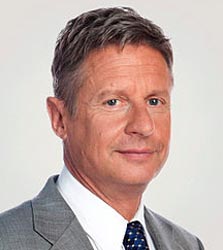
Gary Johnson may be a spoiler - but for whom?
Libertarian Party nominee Gary Johnson is polling in the low-to-mid teens in many polls, and some are looking at him as a potential factor in the 2016 election. But while the former New Mexico governor's small-government approach might seem a natural fit for many Republican voters, and therefore make him more likely to peel votes away from presumed Republican nominee Donald Trump, the polls suggest Hillary Clinton is losing slightly more votes than Trump, as an analyst at FiveThirtyEight.com shows:
Is Gary Johnson Taking More Support From Clinton Or Trump?
Right now, pollsters that include Johnson and, less frequently, Stein are showing Clinton with a slightly smaller lead than pollsters that test only Trump and Clinton. You can see this by looking at the national polls taken since June 1. According to the FiveThirtyEight polling database, 18 pollsters have taken a national poll that asked about the presidential race with only Clinton and Trump offered as an option and in a separate question asked about the race with at least Johnson included. Here is the average margin by which Clinton is ahead of Trump in those polls, with and without third-party options.
The majority of pollsters (12) have Clinton’s margin over Trump shrinking when at least one third-party candidate is included. The difference in margins, however, varies among pollsters, and a few, such as Ipsos, have Clinton’s lead rising by the tiniest of bits when at least Johnson is included. Overall, including third-party candidates takes about 1 percentage point away from Clinton’s margin, on average.
We can argue about the significance of a single percentage point. It’s not a very big deal when Clinton is leading by 5.5 percentage points in the FiveThirtyEight national polling average and is projected to win the national vote by 6.3 percentage points in the FiveThirtyEight polls-only model. (Note that our model prefers the versions of polls that include Johnson. Otherwise, Clinton’s advantage would be slightly larger.1) The discrepancy could, however, become an issue if the race becomes tighter. Although Clinton has been hurt by the inclusion of third-party candidates over the past month, it hasn’t been consistent[.]
The substantial dissatisfaction of many with both major party candidates is likely to make 2016 the best year for third-party or independent candidates since 1992, when Ross Perot earned 19 percent of the popular vote (but no electoral votes). Based on this analysis at least, it appears that Trump may wind up the beneficiary of this dynamic, barely.



